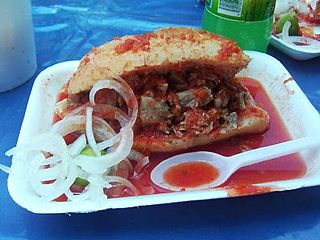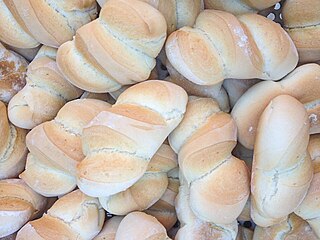
Mexican cuisine consists of the cooking cuisines and traditions of the modern country of Mexico. Its earliest roots lie in Mesoamerican cuisine. Its ingredients and methods begin with the first agricultural communities such as the Olmec and Maya who domesticated maize, created the standard process of nixtamalization, and established their foodways. Successive waves of other Mesoamerican groups brought with them their cooking methods. These included: the Teotihuacanos, Toltec, Huastec, Zapotec, Mixtec, Otomi, Purépecha, Totonac, Mazatec, Mazahua, and Nahua. With the Mexica formation of the multi-ethnic Triple Alliance, culinary foodways became infused.

Cornbread is a quick bread made with cornmeal, associated with the cuisine of the Southern United States, with origins in Native American cuisine. It is an example of batter bread. Dumplings and pancakes made with finely ground cornmeal are staple foods of the Hopi people in Arizona. The Hidatsa people of the Upper Midwest call baked cornbread naktsi. Cherokee and Seneca tribes enrich the basic batter, adding chestnuts, sunflower seeds, apples, or berries, and sometimes combine it with beans or potatoes. Modern versions of cornbread are usually leavened by baking powder.

Wonder Bread is a brand of sliced bread which originated in the United States in 1921 and was one of the first to be sold pre-sliced nationwide in 1930. The brand is currently owned by Flowers Foods in the United States.

The milanesa is a variation of the Lombard veal Milanese, or the Austrian Wiener Schnitzel, where generic types of meat breaded cutlet preparations are known as a milanesa.

Torta is a culinary term that can, depending on the cuisine, refer to cakes, pies, flatbreads, sandwiches, or omelettes.

Pandesal is a staple bread roll in the Philippines commonly eaten for breakfast. It is made of flour, yeast, sugar, oil, and salt.

A bolillo or pan francés is a type of savory bread made in Mexico and Central America. It is a variation of the baguette, but shorter in length and is often baked in a stone oven. Brought to Mexico City in the 1860s by Emperor Maximilian's troupe of cooks, its use quickly spread throughout the country.

Pambazo is a Mexican dish or antojito made with pambazo bread dipped and fried in a red guajillo pepper sauce. It is traditionally filled with papas con chorizo or with papas only but there are different varieties.

Pan de muerto is a type of pan dulce traditionally baked in Mexico and the Mexican diaspora during the weeks leading up to the Día de los Muertos, which is celebrated from November 1 to November 2.

A torta ahogada is a typical dish from the Mexican state of Jalisco, particularly in the city of Guadalajara. Although it is popular in some other parts of Mexico, it is most popular in Guadalajara. It is called "drowned" because the sandwich is submerged totally or partially in a sauce consisting of vinegar, cumin, and a dried chili pepper called chile de árbol. Less spicy versions of the sandwich, made with a tomato-based sauce, are also available.

Mexican street food, called antojitos, is prepared by street vendors and at small traditional markets in Mexico. Street foods include tacos, tamales, gorditas, quesadillas, empalmes, tostadas, chalupa, elote, tlayudas, cemita, pambazo, empanada, nachos, chilaquiles, fajita and tortas, as well as fresh fruit, vegetables, beverages and soups such as menudo, pozole and pancita. Most are available in the morning and the evening, as mid-afternoon is the time for the main formal meal of the day. Mexico has one of the most extensive street food cultures in Latin America, and Forbes named Mexico City as one of the foremost cities in the world in which to eat on the street.

Pan dulce, literally meaning "sweet bread", is the general name for a variety of Mexican pastries. Wheat-based breads were first introduced in Mexico by Spanish colonists, settlers and immigrants; however, Mexican pan dulce as we know it today rose to popularity during the French occupation in the mid 1800s. They are inexpensive treats and are consumed at breakfast, merienda, or dinner.

Mexican breads and other baked goods are the result of centuries of experimentation and the blending of influence from various European baking traditions. Wheat, and bread baked from it, was introduced by the Spanish at the time of the Conquest. The French influence in Mexican Bread is the strongest. From the bolillo evolving from a French baguette to the concha branching out from a French brioche even the terminology comes from France. A baño maría, meaning a water bath for a custard type budín or bread pudding comes from the French word bain marie. While the consumption of wheat has never surpassed that of corn in the country, wheat is still a staple food and an important part of everyday and special rituals. While Mexico has adopted various bread styles from Europe and the United States, most of the hundreds of varieties of breads made in the country were developed here. However, there is little to no baking done in Mexican homes; instead, Mexicans have bought their baked goods from bakeries since the colonial period.

Concha, plural conchas, is a traditional Mexican sweet bread roll. Conchas get their name from their round shape and their striped, seashell-like appearance. A concha consists of two parts, a sweetened bread roll, and a crunchy topping. Conchas are commonly found throughout Mexico in panaderias.
María Belén Bazo Germán is a Peruvian windsurfer.

In Spain, telera is a typical bread from the area of Córdoba. Includes ~W130 wheat flour, sourdough, water, salt and yeast. Its peculiar shape, which resembles a montera, is the result of the deep marks (greña) that are made, generally two, and diagonally along the piece. Being a candeal bread, it is quite durable, but when it gets hard, it is typically used to make salmorejo from Córdoba.















